|
Trash collector...
Owen Coulson, Vestavia Country Club, Birmingham, AL:
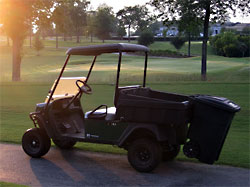  "Each morning our course set-up guys go out and move tee markers, add ball washer fluid, move hole locations, and empty the trash from the cans around the course. Previously they carried a trash can and put it up front with them or put it in the bed of the work cart and trash spilled everywhere in the back of the cart.
I asked Skip (our golf course mechanic) if he could come up with a way to solve this. This is what he came up with. The can slips over the bed and after the set-up guys are done each morning it can be slipped off and the cart can be used for normal duties. Good job Skip!"
Visit Owen's blog at vccturfgrass.blogspot.com
|
 |
|
Green speed: Where does it come from?
Chris Tritabaugh, Northland Country Club, Duluth, MN:
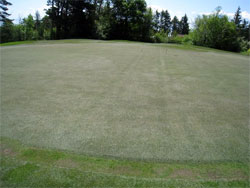 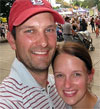 "Last week I heard a couple of comments, both first and second hand, about the speed of the greens. In general the feeling was they were too slow. First of all, they were slow; they are not slow anymore. Second, I think it is important that our membership know: I like fast greens and I want our greens to be fast just as much as you do. However, as a membership you can simply wish for the greens to be fast, while I on the other hand actually have to implement the practices needed to provide the desired speed. Here is a more detailed explanation.
Let's go back just over two weeks ago. It was the middle of June and we had began to dry out from a wet period on and around Memorial Day; nearly seven inches of rain in 10 days. From Monday, June 4th through Wednesday, June 13th the greens were just about perfect. The surfaces had dried out and our growth regulator and fertility programs were right where we wanted them. About two inches of rain fell over the next four days making the course quite wet. On Tuesday, June 19th the greens were scheduled for a regular application of growth regulator and fertility. This application did not take place because of rainfall and you know what happened over the next 24 hours; 9.5" of rain.
"The first mowing after the 100-year storm saw the guys taking six buckets of clippings per green. Desired would be about 1/4 to 1/2 of a bucket per green..." |
After this huge amount of rain we pretty much lost control of growth and thereby green speed. The surfaces went four days without being mowed, the growth regulator ran out and the rain instantly made a ton of nitrogen available to the plants. After four days of not being mowed the greens were nearly as long at the collars. The first mowing after the 100-year storm saw the guys taking six buckets of clippings per green. Desired would be about 1/4 to 1/2 of a bucket per green.
The amount of un-mowed growth which took place on our greens after the 100-year storm is not something we can contain in just a few mowings. Despite four straight days of mowing and rolling over the weekend the greens remained slow due to heavy growth and a lack of growth regulation. It takes a week or so to get this kind of growth under control. Basically it was like starting from the very beginning of the golf season and treating the greens as we do when they are uncovered. At this point even mowing and rolling more frequently, did not solve the speed issue. Unregulated growth along with a nitrogen flush from the heavy rain meant that by afternoon the greens had grown significantly, reducing speed dramatically.
"When missing an application window by seven days we lose growth regulation completely. Getting regulation back takes a few days..." |
Last Tuesday, June 26th we were finally able to make our scheduled green application; one week late. When missing an application window by seven days we lose growth regulation completely. Getting regulation back takes a few days after an application; by Thursday, June 28th we were beginning to get some growth regulation. On Wednesday of this week we will be making another scheduled application to the greens. This will further regulate the growth and improve green speed and consistency.
Did this all seem quite complicated? I hope it did because it is. Getting and attaining consistent green speeds is complicated when the weather is favorable. Throw in 25" of rain in less than 90 days and consistently fast greens become nearly impossible.
Trust me, I like love fast greens and I want to give them to you. Sometimes it is easier said than done and the past weeks this has been the case."
Visit Chris's blog at northlandgrounds.blogspot.com.
|
 |
|
What's up with the greens?
Matt Ceplo, CGCS, Rockland Country Club, Sparkill, NY:
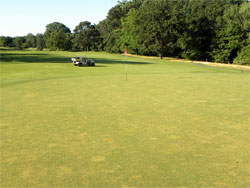
Greens are off color, but are rolling nice.
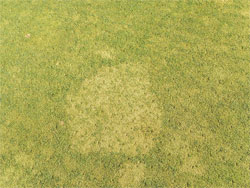
Different types of grasses react differently to the chemicals.
|
 "You probably are wondering what's up with our greens. They are rolling great but boy they don't look so good. It is not because of the weather. It is because we have adopted a new program to keep green speeds up. Simply put, it is a combination of applying growth retardants with fertilizers. We are being pretty aggressive with this program and that is why they are off color. We have recently increased the amount of fertilizer, this will improve the color but because the growth of the grass has been slowed down so much it will take longer for recovery.
I have had many positive comments on the speeds and plan to continue this program for the foreseeable future. Give me a shout if you have further questions. I would be happy to explain the program in more detail if you would like."
Visit Matt's blog at rocklandcountryclub.blogspot.com.
|
 |
|
Summer Aeration & Maintenance Schedule...
Josh Clevenger, Claremont Country Club, Oakland, CA:
 "Over the next few weeks the staff in the turf department will be performing various cultural practices around the golf course. These cultural practices play a huge part in creating the proper environment for the turf to withstand the day to day beating that it takes throughout the year. Much thought and planning goes into the timing and execution of these maintenance practices to ensure that the impact to the membership is minimal and that the benefit to the golf course is to our expectation.
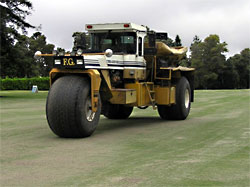 GREEN AERATION AND SANDING:
July 9 - Front Nine & Putting Green
July 10 - Back Nine (CLOSED FOR DAY)
TEE & APPROACH AERATION AND SANDING:
July 11 to July 20
FAIRWAY SANDING:
July 9 and 11
July 23 and 25
I have received many positive comments this year on the condition of the course and those conditions are a direct result of these cultural practices. Thank you for your understanding and cooperation during these maintenance activities. Please know that we will do all we can to get the golf course cleaned up and back in shape following each event."
Visit Josh's blog at claremontturf.blogspot.com.
|
 |
|
What Lies Beneath...
Paul Chojnacky, Pasatiempo Golf Club, Santa Cruz, CA:
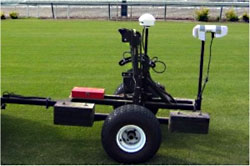
The Toro PrecisionSense unit.
|
 (posted May 29)"This week, an irrigation team from Toro will be scanning our fairways with a specialized machine. This unit will drive up and down each fairway and collect a wealth of data indicating what lies beneath the turfgrass you see at the surface. The PrecisionSense machine will greater identify how every sprinkler in the fairways is performing, tests for soil salinity, identifies heavily compacted areas, and raises awareness about impending turf stress.
"However, we did not change the soil, the topography, or the grass types on the golf course..." |
Yes, we are in our third year of using a new irrigation system and the system itself is running well. However, we did not change the soil, the topography, or the grass types on the golf course. This new technology is part of the irrigation package we installed several years ago and will allow us to optimize the efficiency of our irrigation system. Furthermore, PrecisionSense will help to maximize conditioning through our foliar fertility program. All the data will be compiled and transferred into Google Earth images and we will soon be able to make necessary changes to the irrigation system along with performing cultural practices to help improve upon conditioning throughout the entire golf course.
Some of the benefits include:
Inefficiency of the irrigation system by showing moisture content in the soil Salinity levels and impending drought stress related to excessive salt in the soil Wasted water due to runoff and water/nutrient absorption deficiencies due to compacted soils Dry and wet areas related to topography Turf stress based on any and all of the above
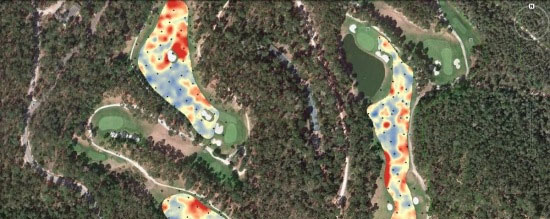
Turf Stress Indicators
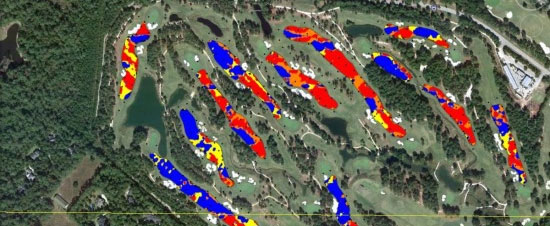
Wet and Dry Zones
Visit Paul's blog at pasatiempomaintenance.com/.
|
 |
|
Greens aeration program... James Beebe, Priddis Greens Golf & Country Club, Priddis, Alberta:
 "Believe it or not, Turf Care staff are probably the only people who dislike the putting green aeration process more than golfers. It is a very difficult and onerous task that takes huge amounts of labour and is very stressful on all staff involved. If the weather does not cooperate and it rains during the aeration process (it always rains during greens aeration) the finished product can be less than the intended standard.
"In reality, golfers do not dislike the aeration process but dislike putting on greens that have aeration holes in them for 10-14 days..." |
Of course, in reality, golfers do not dislike the aeration process but dislike putting on greens that have aeration holes in them for 10-14 days after the aeration process. One of our main goals during the greens aeration process is to minimize the time it takes for the aeration holes to heal over. The healing process is directly impacted by pre- and post-aeration fertilizer practices to encourage growth, the quality of the topdressing process to fill the holes with sand and weather. Staff have control of the the first two items but unfortunately not the weather. If warm sunny days that encourage turf recovery follow aeration the greens will heal quickly and if the weather is cool and wet the holes will stick around longer.
For a more in depth agronomic look at why putting green aeration is important, see this:
http://gsr.lib.msu.edu/article/bevard-putting-3-4-11.pdf."
Visit James's blog at priddisgreensturf.blogspot.com
|
 |
|
Dedication and Perseverence...
Garrett Luck, North Shore Country Club, Mequon, WI:
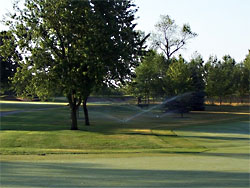
Portable sprinkler in rough on 7 Red.
|
 "After little snowfall over the past winter, a dry spring, and only .36" inches of rain in June, the golf course remains extremely dry. While our automated irrigation system in normally sufficient in providing adequate moisture to the putting greens, tees, fairways, and selective rough areas, we are limited to irrigating areas that are located near sprinkler heads. During periods of extreme drought, outlying rough areas receive no irrigation through our automated system.
Due to the dry conditions and warmer than normal temperatures, unirrigated portions of the golf course have turned dormant. Dormant turf will recover with the onset of rain and cooler temperatures, however these areas are more susceptible to wear and tear from golf cart traffic and simply provide a less than desirable appearance. Additionally, the trees located in these areas are placed under increased stress due to the lack of water.
"Miguel's day consists of hauling thirty 100' sections of 1" hose and 15 sprinklers around the golf course on a rotating basis..." |
In order to assist these areas with recovery, NSCC dedicates one employee to placing portable sprinklers in these areas on a daily basis. Our employee, Miguel, has remained diligent over the last couple months by nurturing acres of rough through these challenging conditions. Miguel's day consists of hauling thirty 100' sections of 1" hose and 15 sprinklers around the golf course on a rotating basis. Each morning Miguel begins at 5AM and finishes around 2:30 PM. Without Miguel's dedication, the roughs would be crispy and dormant. The picture below illustrates the importance of the portable sprinklers in the rough. Don't hesitate to acknowledge Miguel's hard work if you see him on the course."
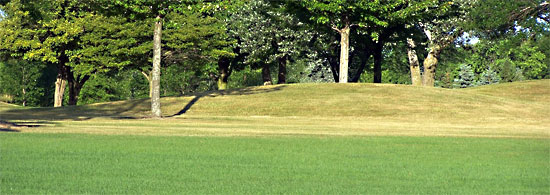
Contrast between irrigated and unirrigated rough
Visit Garrett's blog at nsccgcm.blogspot.com.
|
 |
 |
|
About our Blog Aggregator: Many superintendents are now hosting private blogs to better communicate with their golfers and/or members. Beyond local weather and course conditions, there is a great deal of information about projects, methodologies and techniques that would be of value to other superintendents — hence our Turf Blog Aggregator. As every blogger struggles occasionally with content, we also include posts intended to educate golfers about turf maintenance for others to use as a template for their own blogs.
Miss any previous issues of TBA? You can find them all here.
Turf Blog Aggregator(TM) is a trademark of Turnstile Media Group.
|
|